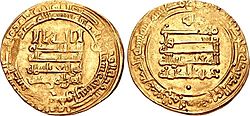A | B | C | D | E | F | G | H | CH | I | J | K | L | M | N | O | P | Q | R | S | T | U | V | W | X | Y | Z | 0 | 1 | 2 | 3 | 4 | 5 | 6 | 7 | 8 | 9
Al-Husayn ibn al-Qasim الحسين بن القاسم | |
|---|---|
 | |
| Born | Abbasid Caliphate |
| Died | |
| Other names |
|
| Occupation(s) | Abbasid vizier and official |
| Years active | September 931 – May 932 (under al-Muqtadir) |
| Parent |
|
| Relatives | Muhammad ibn al-Qasim (brother) |
Al-Husayn ibn al-Qasim (Arabic: الحسين بن القاسم) was a senior official of the Abbasid Caliphate who served as vizier from September 931 until May 932.
Life
Hailing from the Banu Wahb, a family of Nestorian Christian origin that had served in the caliphal bureaucracy since late Umayyad times, al-Husayn was the son, grandson and great-grandson of viziers.[1] The family however had lost power after the death of al-Husayn's father al-Qasim in 904.[2]
He was appointed to the vizierate and the title of Amid al-Dawla ("Mainstay/Pillar of the State") by Caliph al-Muqtadir (r. 908–932) in September 931, with the support of the Banu'l-Furat faction against the rival faction around Ali ibn Isa al-Jarrah and the commander-in-chief Mu'nis al-Muzaffar.[2][3] He quickly managed to win over Mu'nis' proteges, the chamberlain Muhammad ibn Ra'iq and his brother Ibrahim, and began plotting against Mu'nis.[4] The latter tried to secure his dismissal from the caliph, and almost succeeded; it was only his demand that al-Husayn be exiled to Oman that made al-Muqtadir oppose it. At the same time, al-Husayn felt so threatened by the powerful general that he slept in a different house each night to prevent his arrest.[5]
According to the scholar C.E. Bosworth, al-Husayn was "perhaps the last vizier to attempt to retain for the vizierate a measure of its former independence". He tried to restore the state finances, but fell from power due to the incessant court rivalries in May 932.[2]
References
- ^ Bosworth 2002, pp. 33–34.
- ^ a b c Bosworth 2002, p. 33.
- ^ Bowen 1928, p. 311.
- ^ Bowen 1928, pp. 311–312.
- ^ Bowen 1928, p. 312.
Sources
- Bosworth, C.E. (2002). "Wahb". In Bearman, P. J.; Bianquis, Th.; Bosworth, C. E.; van Donzel, E. & Heinrichs, W. P. (eds.). The Encyclopaedia of Islam, Second Edition. Volume XI: W–Z. Leiden: E. J. Brill. pp. 33–34. ISBN 978-90-04-12756-2.
- Bowen, Harold (1928). The Life and Times of ʿAlí Ibn ʿÍsà, ‘The Good Vizier’. Cambridge: Cambridge University Press. OCLC 982525160.
>Text je dostupný pod licencí Creative Commons Uveďte autora – Zachovejte licenci, případně za dalších podmínek. Podrobnosti naleznete na stránce Podmínky užití.
Text je dostupný za podmienok Creative
Commons Attribution/Share-Alike License 3.0 Unported; prípadne za ďalších
podmienok.
Podrobnejšie informácie nájdete na stránke Podmienky
použitia.

